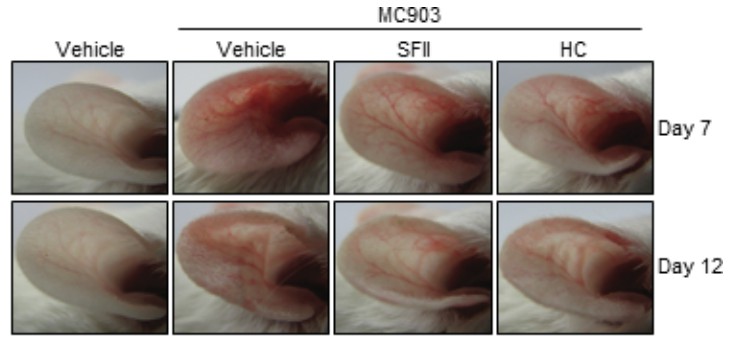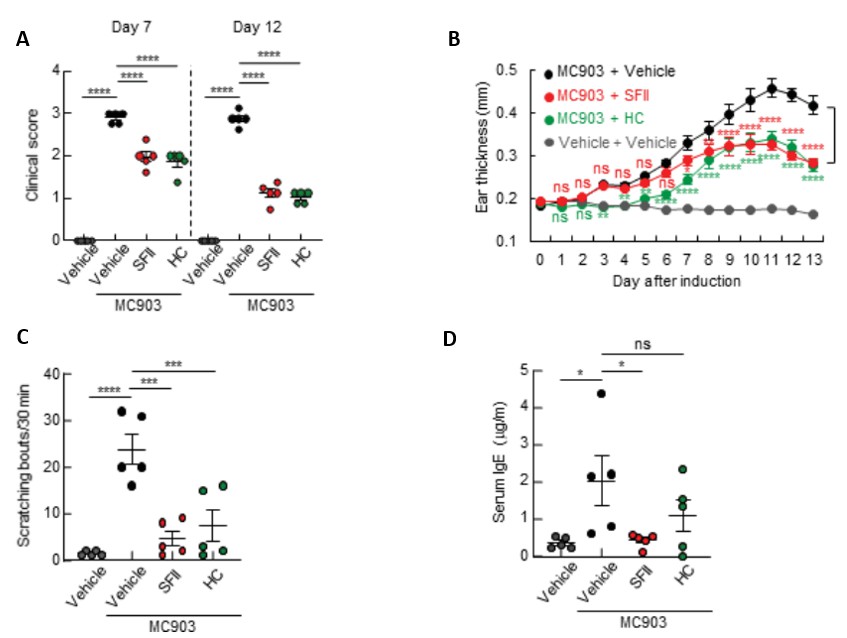- You are here: Home
- Disease Models
- Inflammation & Autoimmune Disease Models
- Atopic Dermatitis (AD) Model
- Calcipotriol (MC903)-Induced Atopic Dermatitis (AD) Model
Disease Models
- Oncology Models
-
Inflammation & Autoimmune Disease Models
- Rheumatoid Arthritis Models
- Glomerulonephritis Models
- Multiple Sclerosis (MS) Models
- Ocular Inflammation Models
- Sjögren's Syndrome Model
- LPS-induced Acute Lung Injury Model
- Peritonitis Models
- Passive Cutaneous Anaphylaxis Model
- Delayed-Type Hypersensitivity (DTH) Models
- Inflammatory Bowel Disease Models
- Systemic Lupus Erythematosus Animal Models
- Asthma Model
- Sepsis Model
- Psoriasis Model
- Atopic Dermatitis (AD) Model
- Scleroderma Model
- Gouty Arthritis Model
- Carrageenan-Induced Air Pouch Synovitis Model
- Carrageenan-Induced Paw Edema Model
- Experimental Autoimmune Myasthenia Gravis (EAMG) Model
-
Cardiovascular Disease Models
- Surgical Models
- Animal Models of Hypertension
- Venous Thrombosis Model
- Atherosclerosis model
- Cardiac Arrhythmia Model
- Hyperlipoidemia Model
- Doxorubicin-induced Heart Failure Model
- Isoproterenol-induced Heart Failure Model
- Arterial Thrombosis Model
- Pulmonary Arterial Hypertension (PAH) Models
- Heart Failure with Preserved Ejection Fraction (HFpEF) Model
-
Neurological Disease Models
- Alzheimer's Disease Modeling and Assays
- Seizure Models
- Parkinson's Disease Models
- Ischemic Stroke Models
- Acute Spinal Cord Injury (ASCI) Model
- Traumatic Brain Injury (TBI) Model
- Hypoxic-Ischemic Encephalopathy (HIE) Model
- Tourette Syndrome (TS) Model
- Amyotrophic Lateral Sclerosis (ALS) Model
- Huntington's Disease (HD) Model
- Intracerebral hemorrhage (ICH) Models
- Pain Models
- Metabolic Disease Models
- Liver Disease Models
- Rare Disease Models
- Respiratory Disease Models
- Digestive Disease Models
-
Urology Disease Models
- Cisplatin-induced Nephrotoxicity Model
- Unilateral Ureteral Obstruction Model
- 5/6 Nephrectomy Model
- Renal Ischemia-Reperfusion Injury (RIRI) Model
- Diabetic Nephropathy (DN) Models
- Passive Heymann Nephritis (PHN) Model
- Adenine-Induced Chronic Kidney Disease (CKD) Model
- Kidney Stone Model
- Doxorubicin-Induced Nephropathy Model
- Orthopedic Disease Models
- Ocular Disease Models
- Skin Disease Models
- Infectious Disease Models
Calcipotriol (MC903)-Induced Atopic Dermatitis (AD) Model
If you're looking for a reliable partner in atopic dermatitis (AD) research, look no further than Creative Bioarray. With our expertise in the calcipotriol (MC903)-induced AD model and our commitment to excellence, we can help you take your research to the next level.
AD is a common chronic inflammatory skin disease characterized by complex pathogenesis and a wide spectrum of clinical phenotypes presenting with underlying skin barrier dysfunction, immune dysregulation, and pruritus.
Calcipotriol (MC903)-induced AD mouse model is well established and is widely used for research on the pathophysiology of human AD. Using MC903, we can induce the secretion of an alarmin, thymic stromal lymphopoietin (TSLP), from keratinocytes through a cell autonomous event dependent on retinoid X receptor/vitamin D receptor, which then induces orchestrated DC-T cells-basophils-T cells cascade-derived Th2-type immune responses by stimulating IL-4 and IL-13 production by CD4+ T cells in skin-draining lymph nodes. By leveraging this powerful model, we can gain insights into the disease. This, in turn, enables us to develop more targeted and effective therapeutic strategies for AD.
Our Calcipotriol (MC903)-Induced Atopic Dermatitis (AD) Model
- Available Animal
Mouse - Modeling Method
Calcipotriol (MC903) is applied on right ear of mouse to induce AD model. - Endpoints
- Clinical score
- Histology analysis: H&E staining
- Serum IgE analysis
- Ear thickness
- Cytokine analysis
- Number of scratching
- Other customized endpoints: available upon request.
Example Data
 Fig. 1 MC903-induced ear skin inflammation of BALB/c mice treated with SFII, or HC on days 7 and 12.
Fig. 1 MC903-induced ear skin inflammation of BALB/c mice treated with SFII, or HC on days 7 and 12.
 Fig. 2 (A) Clinical scores of MC903-induced ear skin inflammation of BALB/c mice treated with vehicle, SFII, or HC on days 7 and 12. (B) Measurement of ear swelling in BALB/c mice treated with MC903 plus vehicle, SFII, or HC using a digital caliper. (C) Scratching bouts of BALB/c mice treated with MC903 plus vehicle, SFII, or HC on day 13. (D) ELISA analysis of serum IgE levels on day 13
Fig. 2 (A) Clinical scores of MC903-induced ear skin inflammation of BALB/c mice treated with vehicle, SFII, or HC on days 7 and 12. (B) Measurement of ear swelling in BALB/c mice treated with MC903 plus vehicle, SFII, or HC using a digital caliper. (C) Scratching bouts of BALB/c mice treated with MC903 plus vehicle, SFII, or HC on day 13. (D) ELISA analysis of serum IgE levels on day 13
In addition, we also provide other AD models that maybe you are interested in:
- Oxazolone-Induced Atopic Dermatitis (AD) Model
- 2,4-dinitrofluorobenzene (DNBF)-Induced Atopic Dermatitis (AD) Model
Quotation and Ordering
Creative Bioarray is a top CRO partner committed to assisting our clients in selecting the most suitable disease models for their research. Our extensive experience, expertise, and range of analytical tests enable us to deliver dependable, high-quality data.
Reference
- Lee, Y., et al. Topical Skullcapflavone II attenuates atopic dermatitis in a mouse model by directly inhibiting associated cytokines in different cell types. Frontiers in Immunology, 2022, 13: 1064515.
For research use only. Not for any other purpose.

